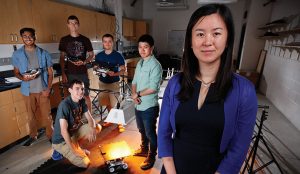
Designing solar-powered vehicles for long-duration, high-efficiency missions
Using renewable energy to power aerial and ground vehicles could change the way we handle aspects of environmental monitoring, search and rescue missions, surveillance, and agricultural practices.
To navigate these sorts of dynamic environments, Ran Dai, an assistant professor in aerospace engineering and Black and Veatch Faculty Fellow, says a solar-powered robotic system offers a lot of promise.
During her first year at Iowa State, she and undergraduate research assistants manufactured the first prototype of a solar-powered ground vehicle in her Automation and Optimization Laboratory.
The vehicle was capable of designing an efficient path to harvest energy from the environment while simultaneously allocating its available power among electric components. The team also created an indoor solar simulator to have a static environment for evaluating the robot’s performance.
Now, confident her ideas will work, Dai has moved forward with a second- and third-generation robot, adding real-time power tracking to record the vehicle’s power intake and consumption, along with a solar-powered unmanned aerial vehicle.
The project is supported by a $500,000 grant provided by the National Science Foundation’s CAREER program, which is designed to support the research and teaching of junior faculty, and will expand the usefulness of these unmanned vehicles even more with advancements that will improve their endurance and capability.
Dai says her biggest obstacle in this work is the weather. “Our algorithms can help the robot make decisions based on available solar energy, but if it’s cloudy, the robot could go into sleep mode to conserve energy, resulting in a delay in completing a mission.”
She says those sorts of delays could be offset with cooperative, back-up vehicles that harvest energy while the other robots are doing work. When the working robots need to recharge, the second group could step in to realize a persistent operation.
“The key to being able to make a system like this work is to find out how to make a robot energy-aware and autonomous,” she says. “That way it could recognize changing solar conditions and make necessary adjustments.”
Dai also plans to develop an open-source software program everyone can use. She hopes this will lead people who are interested in the technology to create their own solar-powered robots.
In the end, it’s the big picture that drives Dai forward — she wants to contribute to the country’s economic vitality, public health and security with these robots.